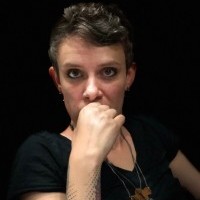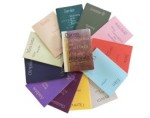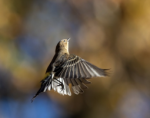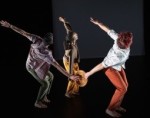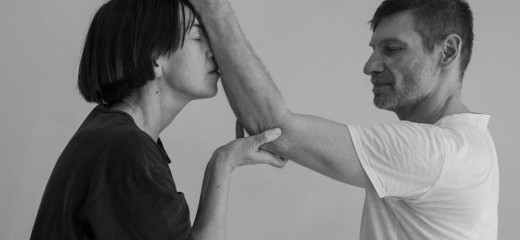
Somatic/Political/Human/Russian
by Emilee Lord
I do not often leave a show this gently stunned or quiet, yet I left the Vaclav Havel Library Foundation on the upper East Side of Manhattan and walked dreamlike through the streets. I was without words, just something lingering in my chest that was heavy and loving after watching Russian-born émigré artists Tarik Burnash and Elena Demyanenko show me what it looks like to hold their grief, their shared history, their anger, and each other.
on the other side is one performance of many in Anew, the 2023 Rehearsal for Truth Theater Festival, a theater festival of eastern European performing artists honoring the playwright and human rights activist Vaclav Havel. Choreographed and performed by Burnash and Demyanenko, it began, as I learned in the talkback, as a private and unstructured way for the two to find healing and hope around what they refer to as "the current aggression of the Russian government." It turned into a profound presentation of somatic resistance.
Structurally the piece moves between intensities, giving you breath between the moments that gut you. It's political without being only political. It's also about human experience and the range of emotions one can have. And it raises questions about what it means to resist, specifically with the body.
They begin casually after walking around and greeting those audience members taking their seats along the three edges of the performance space in the Bohemian Ballroom. The two are wearing comfortable rehearsal clothes and sneakers. They start by telling us how names are being erased in Russia. A repetition builds, listing what is disappearing: books, bodies, names, dance, portions of history. As this raises in pitch and volume, so does the faint recording of an American commentator coming through a speaker sitting on the dance floor.
When they begin to dance, two physical personalities emerge. Initially, it's a pose, melt, pose, melt theme. Burnash strikes the first pose as Demyanenko's last spoken words ring out about the disappearance of Russian ballet. He holds this formal position so long it leaves something of a retinal burn as he moves on. He melts slowly and far away from each new shape with an ease and grace about him like some relaxed figure of an ancient statue, a quiet gathering of strength at rest. His chest firm and calm, the grounded place from which his cries will ring out later.
Demyanenko's energy had more fire or fight in it. She melts less, leaving long lines and balances before ultimately winding fully into the floor, splayed, moving between shapes again, pressing up on her hands. When on her feet again, she forms loose fists and plants her feet knowingly. There is a quiet agitation brewing, visible in her hands, as she pushes, presses, delineates, and tenses. When Burnash moans out a loud, rhythmic bass bellow of sorrow, every exhale a crying out, she finds him, and pressing together at the shoulders, they walk through the space in loops, her agitation and higher pitches the melody. A weight-sharing duet continued, and their vocalizations increased and shifted. Demyanenko seemed in that maddening space of laughter and tears, each barely controlled from overtaking her. They both melt again, but this time into each other, holding on, holding each other up, as they let themselves weep and then come to silent stillness.
Now they dance individually but at a higher energy level. Over time, this more staccato rhythm turns into moments where their feet make the music of the piece, and they clap their hands and slap against their bodies, sometimes syncopated and sometimes aligned. They come to stillness, leaving the space for a while to let it wipe itself clean. Letting us settle into what we just saw before moving on.
The end of the piece was a mounting repetition of words and phrases, breaths, and chattering sounds at the edge of exhausted madness, sounds you weren't sure were laughter that led them to the floor. As the lights dimmed out, they crawled first with each other and then separately around the space, ending with their whispers and me wondering whether or not they found rest.
What happens in a viewer's body when you are watching two people collapse into madness, anger, and weeping? My breath grew heavier, a chesty movement that pulled tension in my throat, and I could feel the shadow of an embrace in my arms. Vulnerable work can sometimes be challenging to watch for many reasons, not least the sense that you shouldn't be there. I didn't find any of that here because although the work was deeply personal, it was also open enough and human enough overall that I could experience it without voyeuristic shame.
The title of the piece, on the other side, encompasses the overwhelming themes of the work. It doesn't just refer to the sides of the conflict but to all sides of the artists and to the multifaceted way that we as humans live and embody who we are, where we come from, how that has shaped us, or how we resist. And it may refer to all the edges of our grief.
I do not know what it is like to come from a war-torn country or to flee one. I don't think all audience members can know, but they certainly can witness. But I can relate to the confusing and intertwined relationship one can have with all their sides, and I can empathize with the effort required to contain all this in the body. As stated by several people in the talkback, it was a great privilege to witness two people feeling, healing, and telling the messy truth.
on the other side, Tarik Burnash and Elena Demyanenko, Anew, the 2023 Rehearsal for Truth Theater Festival, Vaclav Havel Library Foundation, 321 East 73 St., NYC, June 11.
By Emilee Lord
June 18, 2023

